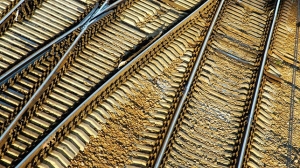Ru
|
Eng
Belarusian scientists come up with unparalleled railroad material
02.02.2016

Belarusian scientists have created a new material codenamed Monicu, which is unparalleled in the world. It can be used to cast railway rails, representatives of the Belarusian Transport University told BelTA.
According to the University’s Professor Leonid Sosnovsky, who is one of the inventors, the parameters of the new material place it between cast iron and steel. The name Monicu is a combination of the first letters of the three chemical elements — molybdenum, nickel, and cuprum. These materials are used as additives to cast iron to make the final product as durable as steel in addition to providing high performance parameters.
It is universally acknowledged that only steel rails have been manufactured all over the world for over 100 years already. These rails get worn out and destroyed in the course of their use, necessitating huge investments in replacements. For instance, 1km of steel rails in single-cut terms costs about $65,000.
Scientists believe that Monicu rails can be twice as cheap. Casting is a simpler and less expensive technology in comparison with steel rolling. Electricity costs alone can be halved by switching to the new technique.
Four experimental rails have been manufactured and used as part of regular railways for 16 months to get them through all seasons of the year. Consequent examination revealed that the service durability of the new rails is roughly on par with steel ones.
The Belarusian invention was recently analyzed during a meeting of chief engineers of the railway administrations of the Eurasian Economic Union member states in Gomel. The specialists univocally spoke in favor of further trials bearing safe operation in mind.
Preparations for a Belarusian-Russian high-level meeting are afoot. The sides are supposed to put together a plan to start manufacturing cast rails. At present the total length of Belarusian and Russian railway tracks exceeds 150,000km. Apart from that, the railway tracks used to connect major industrial enterprises with the main grid represent another 100,000km. The potential of the rail market of the Union State of Belarus and Russia is estimated at 1 million tonnes per annum.
According to the University’s Professor Leonid Sosnovsky, who is one of the inventors, the parameters of the new material place it between cast iron and steel. The name Monicu is a combination of the first letters of the three chemical elements — molybdenum, nickel, and cuprum. These materials are used as additives to cast iron to make the final product as durable as steel in addition to providing high performance parameters.
It is universally acknowledged that only steel rails have been manufactured all over the world for over 100 years already. These rails get worn out and destroyed in the course of their use, necessitating huge investments in replacements. For instance, 1km of steel rails in single-cut terms costs about $65,000.
Scientists believe that Monicu rails can be twice as cheap. Casting is a simpler and less expensive technology in comparison with steel rolling. Electricity costs alone can be halved by switching to the new technique.
Four experimental rails have been manufactured and used as part of regular railways for 16 months to get them through all seasons of the year. Consequent examination revealed that the service durability of the new rails is roughly on par with steel ones.
The Belarusian invention was recently analyzed during a meeting of chief engineers of the railway administrations of the Eurasian Economic Union member states in Gomel. The specialists univocally spoke in favor of further trials bearing safe operation in mind.
Preparations for a Belarusian-Russian high-level meeting are afoot. The sides are supposed to put together a plan to start manufacturing cast rails. At present the total length of Belarusian and Russian railway tracks exceeds 150,000km. Apart from that, the railway tracks used to connect major industrial enterprises with the main grid represent another 100,000km. The potential of the rail market of the Union State of Belarus and Russia is estimated at 1 million tonnes per annum.
SCIENCE. TECHNOLOGY. INNOVATIONS
13.08.2024
28.06.2024
28.06.2024
25.06.2024
05.06.2024
15.05.2024
15.05.2024
26.04.2024
26.04.2024
26.04.2024













